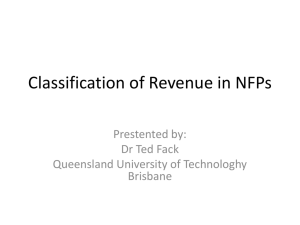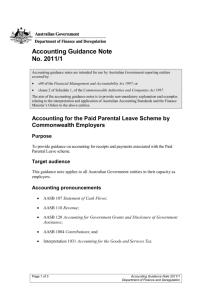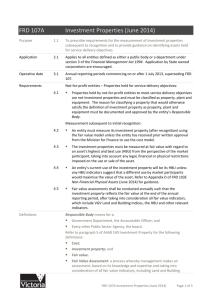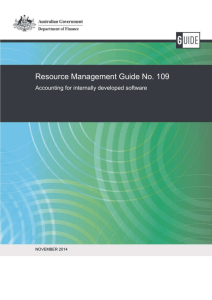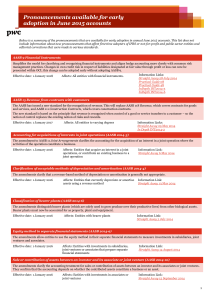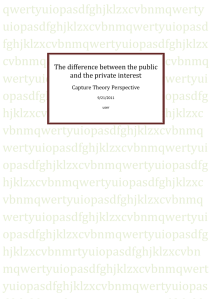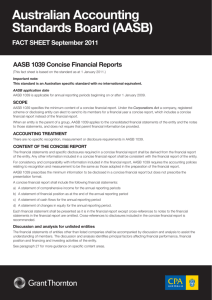Accounting For Research and Development Costs
advertisement
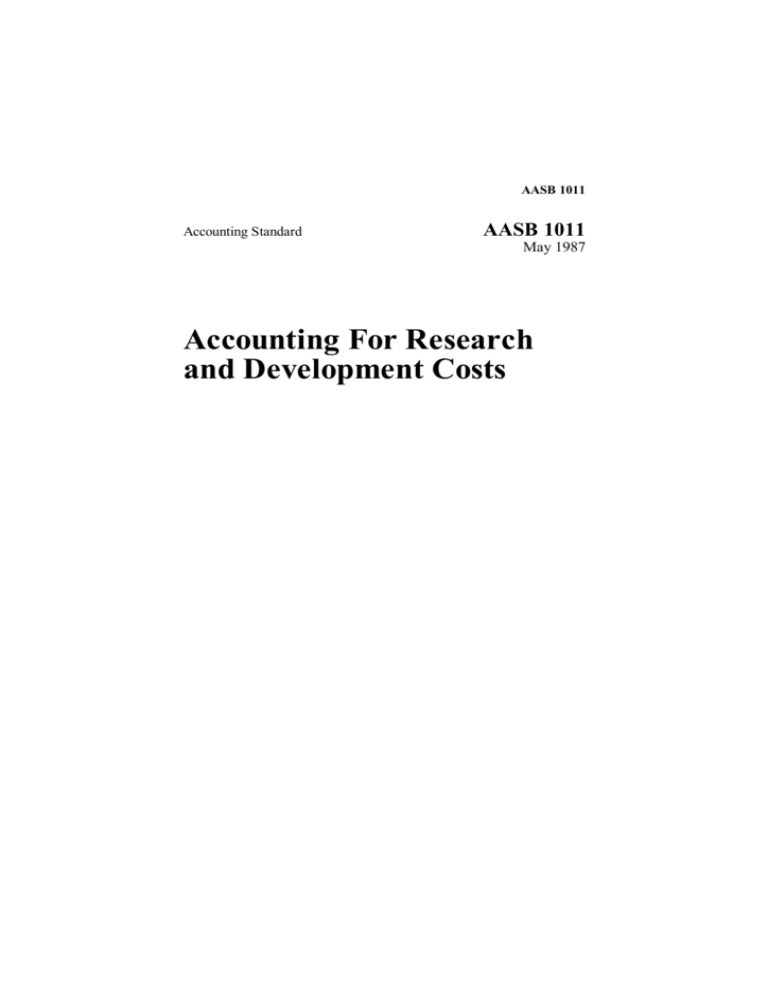
AASB 1011 Accounting Standard AASB 1011 May 1987 Accounting For Research and Development Costs AASB 1011 CONTENTS Starting at Clause: Citation .............................................................................................1011.00 Endorsed explanatory material ..........................................................1011.01 Application .......................................................................................1011.02 Statement of purpose .........................................................................1011.03 Interpretation ....................................................................................1011.04 Application of materiality : Accounting for Research and Development Costs ...............................................1011.05 Definitions ........................................................................................1011.06 Elements of costs to be included in research and development ...........................................................1011.20 Accounting treatment of research and development costs............................................................................1011.30 Accounting treatment of government or other grants received in relation to costs incurred in research and development ....................................................................................1011.40 Research and development costs previously charged to the profit and loss account ..............................................................................1011.50 Disclosure of research and development information .....................................................................................1011.60 Transitional Provision .......................................................................1011.70 COMMENTARY Citation 00 This statement, with the exception of the words shown in italics, may be cited as Accounting Standard AASB 1011: Accounting for Research and Development Costs. [Amended by AASB 1025, para. 8] Endorsed explanatory material .01 The accounting standards set out in this standard are shown in normal print. The endorsed explanatory material is printed in italics. [Substituted by AASB 1025, para. 9] Explanatory material is set out in two ways: (a) immediately after certain of the requirements; and, (b) as a commentary at the end of the standard. AASB 1011 Application .02 This approved accounting standard applies (a) (b) to the accounting for research and development activities other than (i) research and development activities conducted for others under contract; and (ii) specialised activities, in extractive industries, related to the exploration for and extraction of oil and natural gas reserves and mineral deposits to the extent that those activities are not comparable in nature to the research and development activities of other business enterprises; in relation to the first financial year of a company that ends after the expiration of four calendar months from the day on which this notice is published in the Gazette and in relation to subsequent financial years of the company. This standard was published in the Gazette on 29 May, 1987, and applies to the financial years of a company that end on or after 30th September, 1987. In all cases, compliance with a requirement of an approved standard is subject to any relevant provision of the Code. Section 273 of the Code provides that the National Companies and Securities Commission may in certain cases make an order relieving the directors of a company from any specified requirements relating to accounts or group accounts. .02A Notwithstanding anything in clause .02, this standard applies to each company in relation to its financial years that end on or after 30 June 1992 only where the company is a reporting entity. [Inserted by AASB 1025, para. 11] .02B Notwithstanding anything in clause .02, this standard also applies to each company which is the parent entity in an economic entity in relation to its financial years that end on or after 30 June 1992 only where the economic entity is a reporting entity. [Inserted by AASB 1025, para. 11] .02C A company or economic entity which is not a reporting entity shall, when it prepares a financial report which is purported to be a AASB 1011 general purpose financial report, apply this standard as if it is a reporting entity. [Inserted by AASB 1025, para. 11] Statement of purpose .03 The purpose of this accounting standard is to require(a) the application of a method of accounting whereby research and development costs are matched against related benefits when such benefits are expected beyond any reasonable doubt; and (b) the disclosure of material information which will enable users entitled to rely on the accounts or group accounts to assess the significance of research and development costs incurred by the company or group of companies. Interpretation .04 (1) This standard is to be interpreted in accordance with the Corporations Law, including Parts 1.2 and 3.6. The endorsed explanatory material contained in this standard can be used, subject to section 109J of the Corporations Law, as an aid to interpreting the accounting standards contained in this standard. (2) Except for a citation of a replaced or superseded standard in an application clause, any reference in this standard to a standard approved by the Accounting Standards Review Board shall be taken to include the standard as subsequently amended or replaced by a standard made by the Australian Accounting Standards Board as it applies to the financial year for which the accounts and group accounts are being prepared. [Substituted by AASB 1025, para. 17] For example, a reference to Approved Accounting Standard ASRB 1001: Accounting Policies — Disclosure would include, in relation to financial years that end on or after 30 June 1992, a reference to Accounting Standard AASB 1001: Accounting Policies — Disclosure. [Inserted by AASB 1025, para. 18] Application of materiality : Accounting for Research and Development Costs AASB 1011 .05 The accounting standards set out in this standard shall apply to accounts and group accounts where such application is of material consequence. Information relating to the subject matter of this standard is material if its omission, non-disclosure or misstatement has the potential to adversely affect: (a) decisions about the allocation of scarce resources made by users of the accounts or group accounts; or (b) the discharge of accountability by directors. [Substituted by AASB 1025, para. 23] In deciding whether an item is material, its nature and amount usually need to be evaluated together. [Inserted by AASB 1025, para. 24] Definitions .06 In this approved accounting standard unless the contrary intention appears: "balance date" means the end of the financial year to which the accounts or group accounts relate; "carrying amount" means (a) in relation to an asset, the amount at which the asset is recorded in the accounting records at a particular date after deducting accumulated depreciation or amortisation; (b) in relation to a class of assets, the sum of the carrying amounts of the assets in that class; "Code" means, where this approved accounting standard applies in (a) the Australian Capital Territory - the Companies Act, 1981, and the regulations made under that Act; or (b) a State or the Northern Territory - the Companies Code of a State or the Northern Territory as defined in the Companies (Application of Laws) Act of that State or the Northern Territory and the regulations applying under that Code; AASB 1011 "economic entity" means a group of entities comprising the parent entity and each of its subsidiaries; [Inserted by AASB 1025, para. 27] "entity" means any legal, administrative, or fiduciary arrangement, organisational structure or other party (including a person) having the capacity to deploy scarce resources in order to achieve objectives; [Inserted by AASB 1025, para. 27] "financial report" means accounts or group accounts or both; [Inserted by AASB 1025, para. 27] "general purpose financial report" means a financial report intended to meet the information needs common to users who are unable to command the preparation of reports tailored so as to satisfy, specifically, all of their information needs; [Inserted by AASB 1025, para. 27] "group accounts" means, in relation to financial years ending on or after 31 December 1991, consolidated accounts; [Inserted by AASB 1025, para. 27] "group of companies" means, in relation to financial years ending on or after 31 December 1991, economic entity; [Inserted by AASB 1025, para. 28] "parent entity" means an entity which controls another entity; [Inserted by AASB 1025, para. 27] "product" includes product, service, process or technique; "recoverable amount", in relation to an asset, means the net amount that is expected to be recovered (a) from the total cash inflows less the relevant cash outflows arising from its continued use and through its subsequent disposal; or (b) through its sale; "reporting entity" means an entity (including an economic entity) in respect of which it is reasonable to expect the existence of users dependent on general purpose financial reports for information which will be useful to them for making and evaluating decisions about the allocation of scarce resources, and includes but is not limited to the following: AASB 1011 (a) a listed corporation; (b) a borrowing corporation; and (c) a company which is not a subsidiary of a holding company incorporated in Australia and which is a subsidiary of a foreign company where that foreign company has its securities listed for quotation on a stock market or those securities are traded on a stock market; [Inserted by AASB 1025, para. 27] "research and development" means systematic investigation or experimentation that (a) involves innovation or technical risk; and (b) is carried on for the purpose of (i) acquiring new knowledge; or (ii) developing a new product or bringing about a significant improvement to an existing product. "subsidiary" means, in relation to financial years ending on or after 31 December 1991, an entity which is controlled by a parent entity; [Inserted by AASB 1025, para. 27] For endorsed comment see: Paragraphs (i) - (iv): Activities to be identified as research and development activities. Paragraphs (vii) - (ix): Research Paragraphs (x) - (xi): Development Relevant provisions of the Code include: Sub-section 266E(1): "Unless the contrary intention appears in the accounting standard, an expression used in an approved accounting standard has the same meaning as the expression has in this Part [Part VI]". Sub-section 5 (1): definition of "financial year". Sub-section 266 (1): definitions of "accounts" and "group accounts". Reporting entities: AASB 1011 Companies other than the types identified in the definition of "reporting entity" may, in particular circumstances, be reporting entities. Such companies are required to comply with this standard in those circumstances. Paragraphs 19 to 37 of Statement of Accounting Concepts SAC 1 "Definition of the Reporting Entity" provide guidance for determining whether an entity is a reporting entity. [Inserted by AASB 1025, para. 29] Elements of costs to be included in research and development .20 The costs to be included in the amount at which research and development costs are stated shall comprise: (a) the cost of materials and services consumed in research and development activities; (b) the salaries, wages and other related costs of personnel, to the extent that they are engaged in research and development activities; (c) the depreciation of equipment and facilities to the extent that they are used for research and development activities; (d) the amortisation of other assets, such as patents and licences, to the extent that they are related to research and development activities; (e) costs incurred for the company or group by other entities on research and development activities, and charged to the company or group; and (f) other costs that can be attributed to research and development activities and identified with specific projects. For endorsed comment see: Paragraphs (v) - (vi): Elements of costs to be identified with research and development activities. Accounting treatment of research and development costs .30 Research and development costs shall be charged to the profit and loss account as incurred, except to the extent that they meet the criterion for deferral specified in clause .31. AASB 1011 .31 Costs incurred during the financial year on a research and development project shall be deferred to future financial years to the extent that such costs, together with unamortised deferred costs in relation to that project, are expected beyond any reasonable doubt to be recoverable. For endorsed comment on clauses .30 and .31 see: Paragraphs (vii) - (ix): Research Paragraph (x) - (xi): Development .32 Deferred research and development costs shall be amortised over future financial years to match such costs with related benefits, commencing with the commercial production of the product. For endorsed comment see: Paragraph (xii): Amortisation of deferred research and development costs .33 The unamortised deferred research and development costs in respect of each research and development project shall be reviewed regularly and at each balance date and, to the extent that they exceed the recoverable amount, they shall be charged to the profit and loss account for the financial year. Accounting treatment of government or other grants received in relation to costs incurred in research and development .40 Where a grant is received or receivable in relation to research and development costs which have been deferred, the grant shall be deducted from the carrying amount. .41 Where a grant is received or receivable in relation to research and development costs which have been charged to the profit and loss account during this or a prior financial year, the grant shall be credited to the profit and loss account. For endorsed comment on clauses .40 and .41 see: Paragraph (xiii): Accounting treatment of government or other grants received in relation to costs incurred in research and development Research and development costs previously charged to the profit and loss account AASB 1011 .50 Research and development costs which did not previously meet the criterion for deferral specified in clause .31 and were charged to the profit and loss account shall not be written back in the light of subsequent events. Disclosure of research and development information .60 The accounts and group accounts shall disclose if material (a) the amount of research and development costs charged to the profit and loss account during the financial year before crediting any related grants; (b) the amount of research and development costs incurred during the financial year and deferred to future financial years before crediting any related grants; (c) the amount of deferred research and development costs at the end of the financial year, with accumulated amortisation charges being shown separately as a deduction therefrom; and (d) the basis for amortising any deferred research and development costs. Transitional Provision .70 Where the accounting policies required by this standard are not already being applied as at the beginning of the financial year to which this standard is first applied, they shall be applied as at that date. Where this gives rise to initial adjustments, the net amount of those adjustments shall, in accordance with Accounting Standard AASB 1018: Profit and Loss Accounts, be adjusted against retained profits or accumulated losses as at the beginning of the financial year to which this standard is first applied. [Inserted by AASB 1025, para. 35] COMMENTARY Activities to be identified as research and development (i) This accounting standard provides a broad definition of research and development to assist in the classification of research and development activities. It should be noted that research and development includes research work in the social sciences and humanities as well as the physical sciences. The basic principle to AASB 1011 apply is that if the plan or design of the product (which is defined to include product, service, process or technique) is substantially set, subsequent activities are likely to be in the nature of production or pre-production activities. (ii) (iii) (iv) The following are examples of activities that typically are included in research and development (a) research aimed at discovery of new knowledge; (b) searching for applications of new research findings or other knowledge; (c) formulation and design of possible new or significantly improved product alternatives; (d) testing in search of new or significantly improved product alternatives; and (e) evaluation of new or significantly improved product alternatives. The following are examples of activities that typically are included in research and development, where they are carried on for a purpose directly related to research and development activities specified in (ii) (a) design, construction, and testing of pre-production prototypes and models; (b) design of tools, jigs, moulds and dies; (c) design, construction, and operation of a pilot plant that is not of a scale economically feasible for commercial production; and, (d) "feedback research and development" directed at problem solving occurring beyond the research and development phase, for example, solving technical problems arising during initial test production runs. The following are examples of activities that typically are excluded from research and development (a) standard engineering follow-through (in an early phase of commercial production) not in the nature of activities described in sub-paragraph (iii)(d); AASB 1011 (b) quality control during commercial production, including routine testing of products; (c) "trouble-shooting" in connection with break-downs during commercial production; (d) routine on-going efforts to refine, enrich or otherwise improve upon the qualities of an existing product, for example, the making of cosmetic modifications; (e) adaptation of an existing capability to a particular requirement or customer's need as part of a continuing commercial activity; (f) seasonal or other periodic design changes to existing products; (g) routine design of tools, jigs, moulds, and dies; (h) activities, including design and construction engineering, related to the construction, relocation, rearrangement, or start-up of facilities or equipment (including trial and production runs) other than facilities or equipment whose sole use is for a particular research and development project; (i) routine data collection, except where such activities are part of the research and development process; (j) preparing for teaching; and (k) routine or promotional market research, market testing or market development, or sales promotion (including consumer surveys). Elements of costs to be identified with research and development activities (v) The cost of materials and services consumed in research and development activities, and the salaries, wages and other related costs of personnel, to the extent that they are engaged in research and development activities, are included as research and development costs. Where other entities have incurred costs on research and development activities on behalf of the company or group and have charged the company or group for reimbursement, such costs also are included as research and development costs. In addition, those other costs that can be attributed to research and development activities and identified with specific projects are AASB 1011 included. Donations made to other entities such as research institutes are not research and development costs. (vi) The costs of the service potential of assets consumed in research and development activities are included as research and development costs. This includes the depreciation of equipment and facilities to the extent that they are used for research and development activities, and the amortisation of patents and licences to the extent that they are related to research and development activities. Research (vii) Research activities can be segregated into two types - basic research and applied research. (viii) Basic research can be broadly defined as original investigation directed primarily towards the advancement of knowledge. It is undertaken without a specific practical aim or application and, consequently, there rarely exists any relationship between costs incurred on these activities and resulting future benefits. The costs of basic research would normally be charged to the profit and loss account when incurred. (ix) Applied research can be broadly defined as original investigation directed primarily towards solving recognised practical problems. Unlike basic research it is undertaken with a specific practical aim or application. Normally, at the time costs are incurred on applied research activities, any future benefits are too uncertain to warrant deferral of the costs. Thus, the costs of applied research activities would normally be charged to the profit and loss account when incurred. However, because applied research activities are undertaken with specific practical objectives they may, on rare occasions, be associated with identifiable projects and a discernible relationship may exist between these projects and probable future benefits from a successfully marketed product or service or a successful process. In these cases, if the costs of applied research activities meet the test outlined in clause .31 they are deferred and amortised over future financial years. Development (x) Development activities are undertaken with specific commercial objectives and involve the translation of research findings and other scientific knowledge into plans or designs for new products or for significant improvements to existing products. These activities can be associated with identifiable projects and there may be a AASB 1011 reasonable probability of future benefits, whether in the form of increased revenues or reduced costs, arising from such projects. Thus, development costs will meet the test for deferral more often than will research costs. (xi) The likelihood of future benefits arising from particular development projects will vary, depending on the type of project and the prospects for commercial success. In those cases where the expected future benefits are too uncertain to justify carrying the expenditure forward, the costs are treated as an expense and charged to the profit and loss account as incurred. Amortisation of deferred research and development costs (xii) The amount of any deferred research and development costs is to be amortised over financial years in order to match such costs with related benefits. Amortisation will commence with the commercial production of the product and the basis of amortisation employed is to be determined by reference to the benefits expected to arise from the sale or use of the product. Accounting treatment of government or other grants received in relation to costs incurred in research and development (xiii) Where government or other grants are received or receivable by a company or group as reimbursement for costs incurred on research and development activities, the accounting treatment of such grants depends on the accounting treatment of the costs incurred. Where the costs are deferred, the grant is deducted from the carrying amount of the asset. Where the costs have been charged to the profit and loss account the grant is credited to the profit and loss account.
